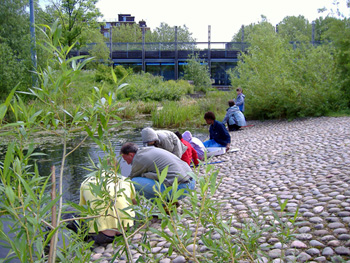Biodiversity
Biodiversity means the variety of life – the countless species of plants and animals on earth and the range of habitats where they live. It also includes the genetic variation within species. Biodiversity includes elephants, sparrows and bluebells; woodlands, rivers and grassland.
It may be hard to believe that Tower Hamlets, an inner London borough, has much wildlife but, if we look more closely, there is much to see. Our parks, squares and burial grounds, waterways, brownfield sites, gardens and even the buildings themselves all provide homes for a variety of wildlife. This includes nationally rare and protected species such as bats and the black redstart. To find out more about the borough’s wildlife, you can visit the Tower Habitats website.
Download our “Go Wild in Tower Hamlets” leaflet.
 Why is biodiversity important?
Why is biodiversity important?
Biodiversity is important in itself. Many people believe we have a moral obligation to conserve the earth’s animals and plants, and the habitats where they live. But biodiversity is also vitally important to people in many ways.
Many people enjoy contact with wildlife and natural places. A mass of evidence in recent years has shown that nature is good for human health – physical, psychological and spiritual.
Natural spaces, even in cities, provide many important social and economic benefits, and these are likely to become more important as our climate changes. Trees provide cool shade in summer. Green spaces absorb rainfall, helping to prevent flooding. Wild plants and animals can be sources of medicines and other essentials for human life. For all these reasons and more, over 150 nations signed up to protecting biodiversity at the Rio Earth Summit in 1992.
What are we doing to conserve biodiversity?
Increased development in the borough poses both problems and opportunities for wildlife. You can download the borough’s Local Biodiversity Action Plan, adopted in July 2019 to start on 1 October 2019, which identifies priority habitats and species and sets the council’s aims and objectives for biodiversity. Biodiversity conservation and enhancement in Tower Hamlets is delivered by Tower Habitats, the Tower Hamlets Biodiversity Partnership. Annual reports on progress towards the targets and objectives of the Plan can be downloaded below. These, along with reports on the previous Local Biodiversity Action Plan, show what we've been doing.
Sites of Importance for Nature Conservation
Places in Tower Hamlets which are valuable for wildlife and provide local people with access to nature have been identified as Sites of Importance for Nature Conservation (SINCs). These receive protection from development under policies in the Council's Local Plan, and are shown on the Policies Map. SINCs in Tower Hamlets were last reviewed in 2016, and the results of this review were adopted in the Local Plan in 2020. You can download a list and map of SINCs and the citations which describe why each site is important, as well as a report on the 2023 review.
Tower Hamlets Wildlife Survey
Please contribute to our survey of wildlife in the borough by telling us where you've seen hedgehogs, stag beetles, sparrows, bats or frogs.
For more information, please contact:
Biodiversity Officer
Sustainable Development Team
Tower Hamlets Town Hall
160 Whitechapel Road
London
E1 1BJ
Tel: 020 7364 7478
Email: john.archer@towerhamlets.gov.uk
Related links